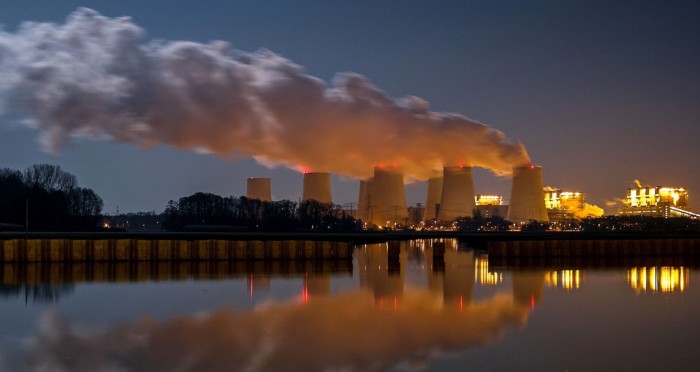Offset start-ups devise smart ways to trap carbon

Roula Khalaf, Editor of the FT, selects her favourite stories in this weekly newsletter.
In a geothermal park in southern Iceland, four squat towers with giant fans will soon whirr into life. Built by Climeworks, a Swiss start-up, the towers will extract carbon dioxide from the air and inject it deep underground, where it turns to rock.
This method, known as “direct air capture”, is at the forefront of carbon removal technology, and can store CO2 for thousands of years.
It is also one of the more novel ways to generate offsets, which are credits for removing CO2 from the air (or reducing emissions) that are bought by companies and individuals seeking to lessen their environmental footprint.
“The special situation in Iceland is that the carbon dioxide can react very, very fast with the underground, and basically be turned into stone,” says Daniel Egger, head of marketing at Climeworks. This process is also one of the most expensive forms of offset available anywhere in the world, costing about €1,000 a tonne at the new plant.
But carbon offsets more broadly — which include many other types of carbon removal credit — are having a resurgence worldwide.
As more companies set goals for net zero emissions, they will need to purchase offsets to cover those emissions they cannot eliminate, so the global market — currently about $400m annually on public registries — is expected to grow even further.
However, offsetting, which has been around since the days of the 1997 Kyoto protocol, can also be highly problematic, and the sector has been dogged by a history of projects that have failed to remove the promised level of CO2.
Technical solutions
Climeworks is part of a growing cohort of start-ups taking a new approach to offsets — one focused on permanently removing and trapping CO2, instead of more traditional offset projects, such as forest restoration and tree planting.
“We need to have technical solutions [like this] to achieve our climate targets,” says Egger. “Nature-based solutions [such as tree planting] often have limited storability — within 50 years it is back in the air.” he explains that trees are very effective at capturing CO2, but the CO2 starts to be released back into the air as a tree decomposes.
Permanent removal projects are still only a tiny minority of offset projects, though. A recent study by Carbon Direct, a consultancy, tracked 1.1bn carbon offsets in official registries, and found that none of the registered projects offered permanent carbon removal.
Still, the approach has attracted a growing number of deep-pocketed backers. Microsoft is one of the customers that will buy offsets from Climeworks’ Orca plant. Brad Smith, the software group’s president, argues that supporting these nascent carbon removal technologies now gives them a chance of being developed further.
“What we are really doing is building a new market, creating a new market — a market where there has not really been an explicit market before,” he says. “It is how we get things moving in the right direction.”
More stories from this report
Can businesses deliver on their climate promises?
Companies grapple with Scope 3 emissions challenge
Consumers keen to be green but confused by companies’ claims
Banks feel the heat on financed emissions
How UK companies got a head start on cutting carbon emissions
We know net zero is the destination — now let’s get moving
Other tech companies have also been active supporters of some of the more avant-garde forms of offsets.
Stripe, the payments company, is spending $1m on a portfolio of “frontier” carbon removal projects that include injecting CO2 into cement, capturing CO2 in limestone on the ocean floor, and buying offsets from Climeworks.
“We will help these technologies get down the cost curve,” says Nan Ransohoff, head of climate at Stripe, She adds that this funding is just the beginning. “The carbon removal field is going to need much, much more to get it to the scale that it needs to be.”
Just a fig leaf?
This year, new efforts are under way to try to get offsets right — particularly ahead of the UN COP26 climate conference in Glasgow this November, where negotiators from around the world will try to iron out a global framework for a carbon market. If approved, that could help create a system that trades carbon offsets between nations.
But critics of offsetting continue to worry that the practice can become a fig leaf for inaction — and argue that companies need to reduce their own CO2 emissions first.
Inger Andersen, head of the UN Environment Programme, says offsets need to have “transparency, independence, verification and rigour” to be meaningful. “We have seen offsets that have been real, and we have seen offsets that have not been as significant or as real as they should have been,” she says.
Even with the recent growth in the offsets market, and the new crop of companies developing permanent removal methods, overall investment in carbon removal is still far below where it should be to meet climate goals, says Jonathan Goldberg, founder and chief executive of Carbon Direct.
“We need significantly more capital to get carbon removal to scale to the point that it needs to go,” he says. “There is more and more interest to support engineered forms of carbon removal, and also more companies doing it.”
Climate Capital

Where climate change meets business, markets and politics. Explore the FT’s coverage here
Comments